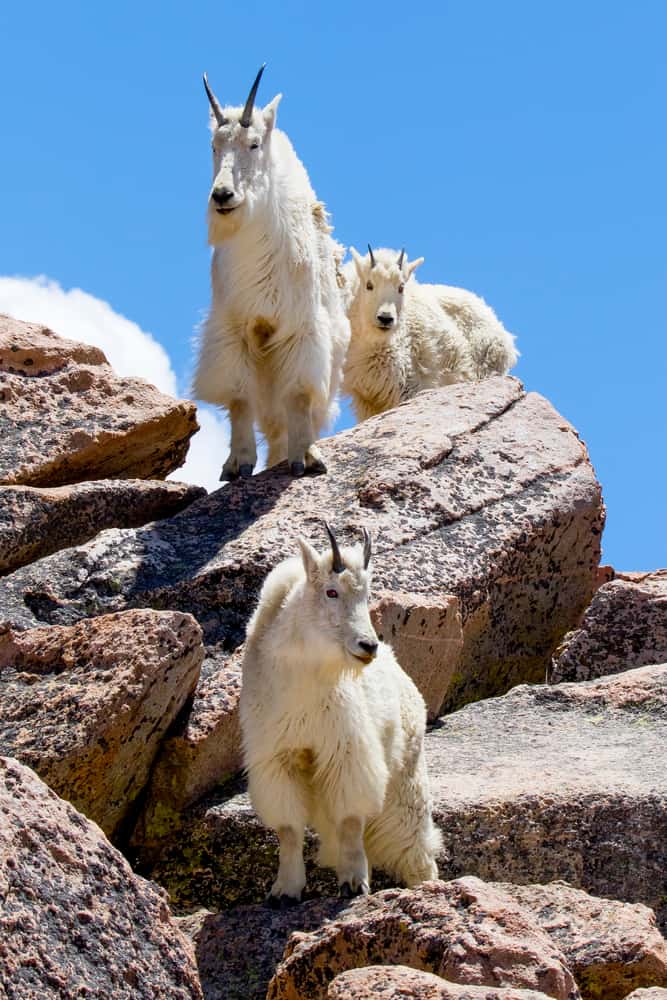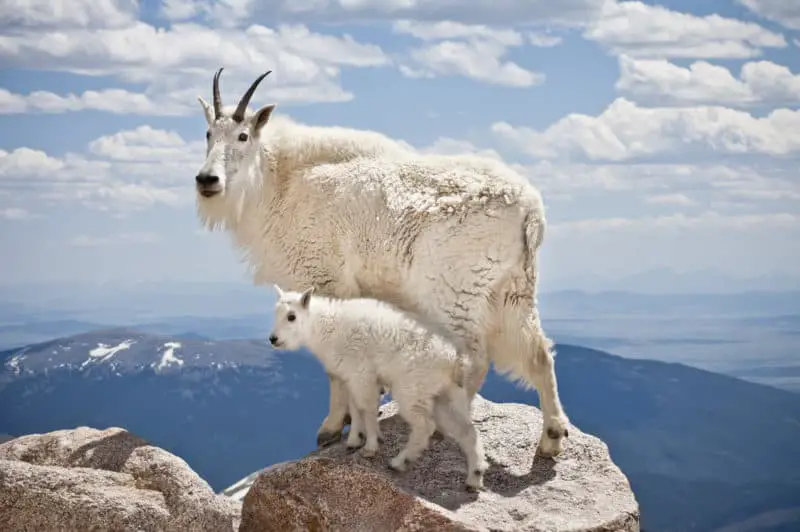Scientific name- “Oreamnos americanus“
Mountain goats are also referred to as the Rocky Mountain goats. They inhabit high steep mountain ranges in the northwestern United States and Canada. Incidentally, they’re not true goats but are closely related to them. They are in the Caprinae sub-family of the Bovidae family with true goats but belong to a different genus.
Mountain Goat Characteristics
What do mountain goats look like? Mountain goats look like a white blocky muscular version of a domestic goat. They have long snowy white hair that is particularly shaggy in the cold part of the year. They have black eyes, nostrils, lips, hooves, and shiny black horns. Both male “billy” and female “nanny” mountain goats have beards that are up to 5 inches long (12.7cm) and short tails. Their pointed black horns curve slightly backward as they rise up from their heads. The horns of males or billies are about 12 inches (30.5 cm) long. On the other hand, the horns on nannies are shorter at 9 inches (23 cm). They never shed their horns but add a new growth ring to them in each year of their life. Billies and nannies both have black scent glands at the base of each horn.
In size, mountain goats display sexual dimorphism as they do in their horns. A billy stands about 3.3 ft (1.01 m) at the shoulder and weighs up to 300 lbs (136.07 kg), while nannies are up to 30% smaller.
Their hair coat is comprised of two layers, a dense wooly inner layer with an outer layer of long hollow guard hairs. Their hair coats keep them warm in winter temperatures that sometimes descend below -50 degrees Fahrenheit (-45.55 C) with occasional hurricane-force winds. In the spring, they’ll shed their winter coats. They help the shedding process along by scratching themselves on available objects in their environment, such as rocks or the stunted gnarled trees called krummholz that grow in their habitat. The Chilkat Tlingit people make clothing and blankets from molted mountain goat fleece. After they’ve shed off their winter coat, the summer coat they’re left with looks very similar, but it’s not as long and shaggy.
Mountain goats are even-toed ungulates, meaning they have split, cloven hooves. Their hooves have a hard outer shell, while their hoof bottoms are concave with rubbery pads to give superior traction on steep slopes. Their split-toed hooves spread open wide for the same reason.
Mountain Goat Range
Mountain goats are native to the mountains of northwestern North America from about 44° N latitude to 63° N latitude. The northwest boundary of their native range begins in southcentral Alaska. It extends south through the length of the coastal range of British Columbia into the United States. The Columbia River in Washington state is the southwestern boundary. From there, their native range extends east across the panhandle of Idaho into western Montana. The eastern border extends from western Montana north along the American and Canadian Rockies to the southern portion of the Yukon territory and spilling over into the Northwest Territory portion of the Mackenzie Mountains. Source
These animals have also been introduced in the Black Hills of South Dakota, Wyoming, Oregon, Nevada, Utah, Colorado, central Idaho, southeastern Idaho, and Washington’s Olympic Peninsula.
The mountain goats in Yellowstone National Park and Grand Teton National Park are not native to the region. Park officials classify them as non-native, exotic species. There is some concern that they compete for habitat with native bighorn sheep.
Mountain Goat population
According to the U.S Forest Service, there are between 75,000 and 110,000 mountain goats. Of these, 33% live in the United States.

Where are some good places to see mountain goats?
- Montana– Glacier National Park. When you drive the famed “going to the sun road” across Logan Pass, you’ll sometimes see mountain goats on the steep cliffs above the road
- South Dakota– Mount Rushmore National Park. Some of these animals are habituated to tourists. They can be found sometimes wandering through the parking lot at Mount Rushmore.
- Wyoming– Sunlight Basin in the Absaroka Range, the Beartooth mountains, Yellowstone and Grand Teton National parks
- Washington– Olympic National Park
- Oregon– The Wallowa, Elkhorn and Strawberry mountains, of eastern Oregon all have mountain goats. There are also mountain goats in the Cascade Range, both in Oregon and Washington.
- Nevada– The East Humboldt and Ruby Mountain Ranges
- Utah– Wasatch, Uinta, Tushar, and La Sal Mountains
- Colorado– You can find mountain goats in various places along the front range. Many of the places are way off the road. Some places where you have a possibility of seeing one from the road are Rocky Mountain National Park, the Mount Evans highway, Independence Pass, and the Pikes Peak highway. The Sawatch range also has mountain goats. Finally, you can spot them from the “Million Dollar Highway” from Silverton to Ouray
- Idaho– In the panhandle, in the White Cloud Mountains of central Idaho and in the southeastern corner of the state.
- Alaska– According to the Alaska Department of Fish and Game, you should look for them in the southeast panhandle and along the coastal mountains to Cook inlet. There are also mountain goats in the Chugach Mountains, the Wrangle mountains, and the Talkeetna Mountains. In some areas they share habitat with Dall sheep. Additionally, there are introduced mountain goat populations on Kodiak Island, Baranof Island, and Revillagigedo Island. Source
- Alberta– Look for mountain goats in Jasper National Park.
- British Columbia– Mountain goats inhabit the entire length of the Coastal Range in British Columbia.
- Yukon– Mount White in the Agay Mene Territorial Park and the South Klondike highway along the border with British Columbia.
- Northwest Territories– The Mackenzie mountains on the border with the Yukon territory.
Mountain Goat Habitat
Mountain goats live in the steep rugged terrain from sea level along the coasts of British Columbia and Alaska, to above 13,000 ft., ” 4000 m ” in elevation, in subalpine environments and alpine environments. Lucky for them, they’re well adapted for this kind of exitance. Their physical adaptations allow them to climb steep rocky slopes and cling to the sides of near vertical cliffs.
They spend most of their lives above the tree line, but will migrate to lower elevations or higher elevations depending on the season, the availability of food, and the severity of the weather.
What Do Mountain Goats Eat?
In the late spring and summer, mountain goats are above the tree line in the Alpine biome. Here a mountain goat’s diet consists of lichens, grasses, ferns, and low-growing shrubs such as cushion plants and the leaves and buds from deciduous and coniferous woody plants such as the krummholz tree shrubs that grow in their high alpine environment. What’s more, their daily movements are affected by their need to use salt licks and mineral licks.
Depending on the severity of the weather and the availability of food, mountain goats will migrate to lower elevations in the winter. In fact, on the Alaska and British Columbia coastlines, mountain goats will sometimes move right down to sea level in the wintertime to feed on kelp.
What eats mountain goats?
When mountain goats are in their summer habitat, they’re safe from most predators, with the exception of mountain lions. These animals are the only large predators agile enough to reach mountain goats in rugged alpine terrain. Golden eagles are also a threat to take mountain goat kids. They do this by knocking them off a ledge and feeding on the dead carcass.
When mountain goats go to lower elevations, they become fair game for other predators such as wolves, coyotes, wolverines, and occasionally black bears and brown bears.
Mountain Goat Life History
Rocky Mountain goats come into heat in a synchronized group in late October through early December. At this time, they are not monogamous, but sometimes billies will try to keep certain nannies away from other billies.
After the mating season is over, nannies and billies go their separate ways. Adult billies go into small groups of 2 or 3, while pregnant nannies may form bands of up to 50 animals.
The gestation period for mountain goats is around six months. Hence, the season for kids to be born is from late May to the middle of June. The majority of the time, mountain goats give birth to one kid. However, 33% of the time, they give birth to twins.
Nannies go to an isolated spot to give birth. After the kid is born, they lick them dry and eat the placenta, probably to eliminate as much scent as possible that predators could zero in on. This trait is common in all hooved animals, even domestic ones.
Birth
Newborn kids weigh about 6 1/2 pounds “3 kg”. They are precocial. They’re able to stand and nurse within 45 minutes of birth. Subsequently, a day after birth, they’re able to run and climb right along with their mother.
Newborn kids and their mothers stay in seclusion for around two weeks. From there, they go and join other nannies with kids in nursery bands.
Young goats start to eat vegetation after they’re about a week old. However, they’ll continue to nurse for about four months. After mountain goat kids are weaned, they’ll continue to follow their mothers through the first year, until their mother gives birth again. If their mother doesn’t give birth in the following year, they may stay together longer.
While male goats live a solitary existence through the winter, adult females live together in small bands. However, in the event of a severe winter when food sources become scarce, females may become territorial and competitive for scarce resources.
Reproductive Age
Both genders of Rocky Mountain goats reach sexual maturity at around 18 months of age. However, they probably won’t reproduce at this time. In the wild, most females reproduce for the first time at 30 to 54 months of age. On the other hand, sub-adult billies generally do not get to do any of the breeding. Most of the time, billies are older than 42 months before they win any of the breeding privileges. Source
Life Expectancy
Mountain goats in the wild live up to 18 years. Their life expectancy is tied to how long it takes for their teeth to wear down. Consequently, mountain goats in captivity live a bit longer due to the difference in their diet. In captivity, mountain goats live up to 20 years.
Mountain Goat Facts
- Mountain goats may look and act peaceful, but they become fierce when they feel threatened. There is at least one account of a mountain goat killing a grizzly bear with its horns. There’s also one account of a mountain goat goring a hiker to death. See No matter how accustomed people and mountain goats might become to each other, they’re still wild animals, so keep your distance.
- Mountain goats can leap up to 12 feet
- The Salish, and the Chilkat Tlingit peoples of the Pacific northwest traditionally weave blankets with mountain goat wool. They gather the goat’s winter wool after it has been shed in the spring. Source
Recent Posts
The only venomous snakes in Washington State are Northern Pacific Rattlesnakes. The Northern Pacific Rattlesnake (Crotalus oreganus oreganus) is a sub-species of the Western Rattlesnake. Anyone...
Skunks are not classified as true hibernators. But they go into a state of torpor when the weather gets cold. Skunks are light sleep hibernators, along with opossums, bears, and raccoons. ...

